《大学体验英语3》教学大纲
[所有分类]大学体验英语3第三册教案
![[所有分类]大学体验英语3第三册教案](https://img.taocdn.com/s3/m/44233d6504a1b0717ed5dd6e.png)
教案扉页章节教案课时教案课时教案Passage A: Care for Our Mother EarthStep 1 Greetings and a brief revision (pair work or group work)Ask one or two pairs (groups) to act out their own dialogues.Step 2 Talking about the pictures and providing some related information (class work or individual work)Related InformationGlobal Climate TrendsThe main drive behind climate change is the increasing amount of carbon dioxide in the atmosphere. Its level has risen by a third since the industrial revolution started in the 1760s. As CO2 has built up, so temperature has risen. The main culprits behind increasing CO2 levels are burning fossil fuel s and deforestation. The US alone pumps out a quarter of the world’s CO2 emission.Global Pollution TrendsIf the number of cars keeps increasing at the present rate, there will be more than a billion on the road by 2025. Today, motor vehicles put out 900 million tons of carbon dioxide a year—about 15 percent of our total output. More vehicles will mean more global warming. Also by 2025, two-thirds of the world’s people will live in cities, so traffic jams and pollution will loom large in most people’s lives.Global Population TrendsNever has the pressure on the world’s r esources been so great. Over the next 20 years, the global population is expected to grow by a quarter –that’s an extra 1.5 billion mounts to feed. Water is also under pressure as never before. Today, some 500 million people do not have enough water. By 2025, that number is expected to hit 2.5 billion.Awareness MagazineAwareness Magazine is a bimonthly magazine, which came into being in 1993, and claims to devote itself to making our planet a better place to live in.Summary: In an interview for Awareness Magazine, four specialists discuss their views on environmental issues with Dr. Mckinley. Leon Nacson is particularly worried about air and water pollution and Walter Semkiw is especially concerned with deforestation and global warming,课时教案章节教案课时教案课时教案课时教案课时教案章节教案课时教案课时教案课时教案课时教案章节教案课时教案课时教案课时教案课时教案章节教案。
大学体验英语unit3教案
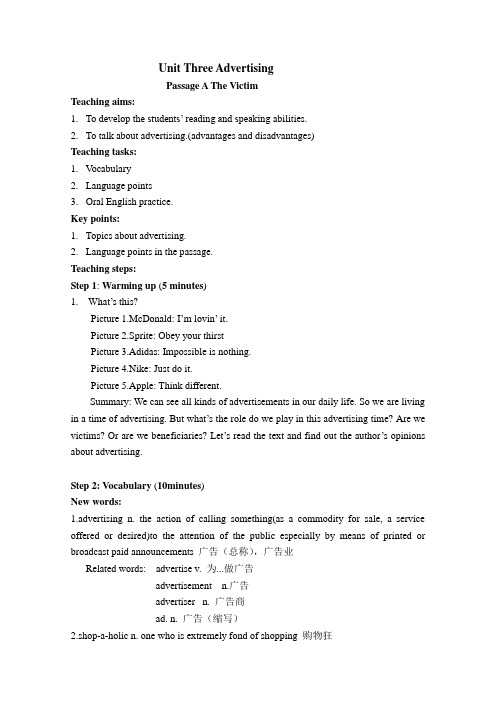
Unit Three AdvertisingPassage A The VictimTeaching aims:1.To develop the students’ reading and speaking abilities.2.To talk about advertising.(advantages and disadvantages)Teaching tasks:1.V ocabularynguage points3.Oral English practice.Key points:1.Topics about advertising.nguage points in the passage.Teaching steps:Step 1: W arming up (5 minutes)1. What’s this?Picture 1.McDonald: I’m lovin’ it.Picture 2.Sprite: Obey your thirstPicture 3.Adidas: Impossible is nothing.Picture 4.Nike: Just do it.Picture 5.Apple: Think different.Summary: We can see all kinds of advertisements in our daily life. So we are living in a time of advertising. But what’s the role do we play in this advertising time? Are we victims? Or are we beneficiaries? Let’s read the text and find out the author’s opinions about advertising.Step 2: Vocabulary (10minutes)New words:1.advertising n. the action of calling something(as a commodity for sale, a service offered or desired)to the attention of the public especially by means of printed or broadcast paid announcements 广告(总称),广告业Related words: advertise v. 为...做广告advertisement n.广告advertiser n. 广告商ad. n. 广告(缩写)2.shop-a-holic n. one who is extremely fond of shopping 购物狂Related words: alcoholic n. 酒鬼,酗酒者workaholic n. 工作狂3. closet n. cupboard or small room for storing things 衣橱4.clutter v. make untidy or confused 胡乱地填满5.victim n. a person, animal or thing that is injured, killed or destroyed as the result of carelessness, crime or misfortune 受害者牺牲品6.define v.state precisely the meaning of 给...下定义(definition 定义)7.quest n.&v. act of seeking sth, attempt to find 寻求e.g. He went to the library in quest of something to read.They have been questing for a new method of language teaching for years.8.upcoming adj. coming up 即将来临的9. underlying adj. lying under or beneath 潜在的e.g. There is an underlying inconsistency here.10.societal adj. of or relating to society 社会的(related word: society 社会)11.foster v. help the growth or development of (sth.) 培养,促进e.g. foster an interest in music12.glamorous adj. characterized by or full of glamour 富有魅力的13.consumption n. using up of food, energy, resources, etc 消费(related word: consume)Phrases:1. a lover of fashion 时尚爱好者2. name-brand items 名牌产品3. get what sb. pays for 物有所值4. a victim of advertising 广告的受害者5. preppy all-American girl 干净利落的典型美国女孩6. snobby rich girl 自命不凡的富家千金7. upcoming style 最新潮流8. underlying images 潜在信息9. a certain look 特定类型Step 3:Text Understanding (25 minutes)1. Now let’s read the text (the whole class) and find out the outline of the passage.(10 minutes)Please read the passage with the following questions:(1). How many parts can this passage be divided into according to the author's opinion?(2). What's the main idea of each part?Outline:Part I (para.1) : Introduction.Part II (paras.2-4) : The author’s own experience.Part III (para.5) :The author’s analysis of advertisers’ and consumers' psychology. Part IV (Para. 6): Conclusion.2. Interactive Activities (Group work): (15 minutes)Divide the students into 3 groups and talk about the topics in Part II.Periods Attitude towardsClothes Influence ofadvertisingMy experienceIn my childhood In middle school In collegeAnswers:Periods Attitude towards Clothing Influence ofadvertisingMy experienceIn my childhood I wore what my mother gave me orthe hand-me-downs from my sister.Never questioned how I looked, butI liked to dress up.No influenceIn middle school I became concerned with my appearance. Wanted to look good.The clothing became something thatdefined a person.Big influenceIn college Clothing begins to define a personless and less. It shows one’spersonality. It reflects but notdefines a person.Remain a victim ofadvertising.Step 4: Intensive reading (with Language points). (25 minutes)△Y ou could call me a shop-a-holic… a lover of fashion:Y ou could call me a shopping addict, as mo st of my friends do, but I’d rather say I love to buy things in fashion.△But as I progressed to high school, advertising became a big influence:But as I moved ahead to high school, I paid more attention to advertising.△The clothing in high school became something that defined you:High school students seem to adopt a notion that by wearing expensive clothes they are wealthy, smart, or superior in some way.△Y et my friends and I still turn to advertising… to find our own style:Y et my friends and I still pay attention to advertising, not only to follow the fashions, but more to find our own personal style.△Advertisers show us people around us, yet they choose only a certain look: We see average people in the advertisements, but they are shown in deliberately chosen images.△Advertising feeds off human insecurities and makes us want to be like these beautiful people.Advertising makes people insecure about who they are and need expensive clothes to make them look good.△Is it the victim’s fault …to do so?Is it the buyer’s fault for believing the advertising, or society’s fault for allowing ads to be made so powerful and influential?Important words and phrases:△clutter: make untidy or confused 胡乱地填满e.g. The room was cluttered with furniture.The road was cluttered with refugees.△dress up: make (sth. or oneself) more attractive, esp. with clothing穿戴,打扮e.g. Y ou do not need to dress up for the dinner.Are you going to dress up for the party, or is it informal?△identify ... with: consider sth. to be identical with sth. 与...等同e.g. Never identify opinions with facts.△turn to: got to… for help, advice, sympathy, etc 求助于e.g. I had to turn to the dictionary for help.The child felt there was no one he could turn to with his problems.△quest: act of seeking sth, attempt to find 寻求e.g. He went to the library in quest of something to read.They have been questing for a new method of language teaching for years.△look to: depend on to provide help, advice 向...求助e.g. We look to you for help/to help us.An able young man is ashamed to look to others for assistance.△step back: think about as if not involved 置身事外e.g. From time to time, the teachers should step back and let their pupils run thingstheir way.Step 5: Debate & Exercises (25 minutes)1. Debate: Is advertising good or bad for our society?(This competition not only provides a stage for students to develop their debating skills but also makes them more confident in expressing their thought in a foreign language.)Step 1. PreparationStep 2. Position Presentation-ProPosition Presentation-ConStep 3. Free debateRebuttal & Response- ProRebuttal & Response- Con(all speakers -- questions & answers)Step 4. Conclusion: Position Summary- ProPosition Summary- Con2. Exercises: Do the exercises 2-8.3. Homework: Find out five interesting Chinese advertisements in your life and translate them into English.。
大学体验英语综合教程3(第三版)课件unit3-listen-and-talk
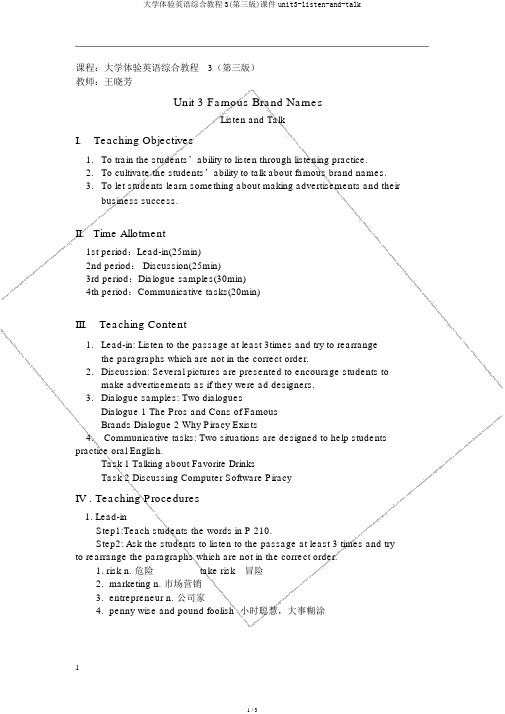
课程:大学体验英语综合教程3(第三版)教师:王晓芳Unit 3 Famous Brand NamesListen and TalkI.Teaching Objectives1.To train the students’ability to listen through listening practice.2.To cultivate the students’ability to talk about famous brand names.3.To let students learn something about making advertisements and theirbusiness success.II.Time Allotment1st period:Lead-in(25min)2nd period: Discussion(25min)3rd period:Dialogue samples(30min)4th period:Communicative tasks(20min)III.Teaching Content1.Lead-in: Listen to the passage at least 3times and try to rearrangethe paragraphs which are not in the correct order.2.Discussion: Several pictures are presented to encourage students tomake advertisements as if they were ad designers.3.Dialogue samples: Two dialoguesDialogue 1 The Pros and Cons of FamousBrands Dialogue 2 Why Piracy Existsmunicative tasks: Two situations are designed to help students practice oral English.Task 1 Talking about Favorite DrinksTask 2 Discussing Computer Software PiracyIV . Teaching Procedures1. Lead-inStep1:Teach students the words in P 210.Step2: Ask the students to listen to the passage at least 3 times and try to rearrange the paragraphs which are not in the correct order.1. risk n. 危险take risk冒险2.marketing n. 市场营销3.entrepreneur n. 公司家4.penny wise and pound foolish 小时聪慧,大事糊涂2.DiscussionStep 1. Show students with several pictures of world famous brands which are familiar to students and tell their successful stories.Step 2. Ask students to form partners or groups to design advertisements with the help of the pictures.1)sell a house to a snail2)sell a refrigerator to an Inuit3)sell a swimming suit to a fishFor reference: Inuit are a group of culturally similar inhabitingthe regions of , , and . Inuit is a plural noun; the singular is Inuk. The word Inuit means "the people" in the Inuit language of Inuktitut.3. Dialogue samplesStep 1. (1)Ask students to listen to dialogue 11.designer n. 设计师2.insecure adj. 无掌握的,不一定的3.catwalk n. 时装秀台4.beyond one’s means 高出某人的支付能力5.sturdy n. 结实的6.underwear n. 内衣(2)Ask students to repeat the dialogue line by line with one speaking after the other.Step 2. (1)Ask students to listen to dialogue 21.piracy n. 盗版行为2.author v. 创作第一版3.undercut v. 低价销售4.elite n. 精英(2)Ask students to repeat the dialogue line by line with one speakingafter the other.municative tasksAsk students to create a dialogue with their partner according to thegiven situation, using the expressions and sentence patterns formaking the interviews in the table.Situation 1Two students are talking about their favorite drinks, each trying to arguefor his / her own preferred brand and against the other ’ s .choice For referenceA:Hmmm, I’ m thirsty. Shall we go and get a drink?B:Yeah, that sounds like a good idea. I could do with a nice cup of tea.A:Tea! Yuck! Coke for me.B:Coke? Do you really like it? I always think it tastes so artificial ...and it ’ s so sweet.A:And you like the taste of tea?大学体验英语综合教程3(第三版)课件unit3-listen-and-talkB:Well, at least tea doesn’ t rot my teeth.A:That depends on how much sugar you put in.B:I don ’ t put sugar in my tea. I drink it‘ cos it’ s natural, and it tastes g Besides, coke’ s muchre moexpensive.A:Some things are worth spending money on.B:Maybe, but coke’ s beyond my means. And my theory is that tea’ s healthy, it’ s good for you.A:Well, that depends on what kind of tea you drink. You know someteas have loads of caffeine in them ... more than coke even.B:Huh, okay. I can see I’ m not going to win this one. And all this talking ismaking me thirsty. Let ’ s go and get that drink. You can have your coke if youwant to. I ’ ll stick to my tea.Situation 2Two friends are discussing computer software piracy.For referenceA:Hey, I got a great new program for my computer yesterday. It ’ s a brilliant game.You should come over and play.B:Another program? I don’ t know how you can afford them all.A:Well you know ... it’ s a pirate copy.B:Don’ t you feel bad supporting the pirates?A:I can ’ t afford the real thing!B:But it ’ s illegal ...A:Illegal to want to save money? It’ s as good as the real thing but costs a quarter of the price.B:Maybe, but you see the problem is that with pirates the peoplewho really do all the work end up losing out.A:Look, I’ m just an average consumer. I’ ve got to think about what’ s g for me.B:But in the long run it’ s not good for you. This pirate thing is getting out of control. You see, the more money the manufacturers lose throughbeing pirated, the higher the price of the real thing will become. Inthe end only an elite few can afford the genuine articles.A:I see what you mean. But if they made the programs cheaper theycould reduce the illegal copying.B:But they wouldn ’ t make any profit!A:In the short term perhaps but in the longer term they probably would.Honestly, I’ d prefer to buy the originals but I just can’ t. Now do youwant to come and play or not?V. AssignmentAsk students to work in pairs to discuss how to make advertisements, and previewthe passage A.。
河北科技大学大学体验英语3课程教学大纲(2)

河北科技大学《大学体验英语3》课程教课纲领高起本非英语专业一、教课对象本课程为公共英语课,教课对象是河北科技大学高起本非英语专业的学生。
二、教课目标大学英语教课的目的是,培育学生拥有较强的阅读能力和必定的听、说、写、译能力,使他们能用英语沟通信息。
掌握优秀的语言学习方法,打下扎实的语言基础,提升文化修养,以适应社会发展和经济建设的需要。
三、教课要求本课程采纳由宁春岩主编,由高等教育第一版社第一版的《大学体验英语》系列教材,计划四个学期学完第一、二、三册。
详细要求以下:1、词汇:在二级的基础上掌握550-600单词(此中18%可经过泛读和其余学习项目掌握) 以及由这些单词组成的常用词组。
对此中300 左右的常用词要求拼写正确,并掌握它们的基本用法。
2、读:精读量:7000-8000 词;泛读量:30000-35000 词。
能正确理解与课文难度相仿的文章。
学会基本阅读技术 ,阅读速度达到每分钟 65 词。
阅读难度略低、生词不超出总词数 3%的资料 ,速度达到每分钟 65 词,理解正确率以 70%为合格。
3、听:能听懂英语授课及简洁会话、讲话和讲座,抓住中心粗心、重点和相关细节,领悟作者看法和态度。
对题材熟习、句子构造比较简单、基本上没有生词、语速每分钟约 120 词的听力资料 , 两遍能够听懂 , 理解正确率以 70%为合格。
4、写:能在阅读难度与课文相仿的书面资料时做笔录、回答下列问题和写纲要,能就必定的话题和纲要在半小时内写出 100 词左右的短文,能写短信和条子。
表达意思清楚,无重要语法错误。
5、说:能进行简单的平时会话, 能就教材内容作简洁问答和复述。
能就熟习的话题作简洁讲话,表达思想基本清楚。
四、教课安排每学期总学时 24 学时(面授),每周自学应不低于 4 学时。
本学期自学内容:综合教程第三册第5至6单元;听闻教程第三册第9至 12单元寒假时期面授计划:综合教程第三册第7、8 单元听闻教程第三册第13 至 15 单元自学内容要求以下:综合教程:第五单元1.阅读技巧: P110 上下文含义2.翻译技巧: P111 分句译法3.一般写作: P111 经过举例睁开段落4.应用写作: P112 网上节目介绍第六单元1.阅读技巧: P130 语意图义2.翻译技巧: P131 合句译法3.写作技巧: P131 经过类比与对照睁开段落4.应用写作: P133 旅游行程安排听闻教程:第六至第十二单元五、测试1、测试是检查教课纲领履行状况、评估教课质量的一种有效手段,是获得教课反应信息的主要根源和改良教课工作的重要依照。
大学体验英语3听力教案.doc

周次第周日期节次授课内容Unit 2 identity 授课学时2学时教学目的 1.T o learn to introduce people2.To learn and master the vocabulary and expressions教学重点Listing and answering教学难点The appreciation of listening教具和媒体使用多媒体,黑板教学方法讲授,师生互动练习教学过程A.warm upB.listening taskC.real world listeningD.interactive practice思考题作业Exercise of unit 2A. warm up(Answers in bold.)1.Ms. Kelsey is a librarian, but she's passionate about sports cars.2.Kris rides a motorcycle, but she5s also a nerd when it comes to history・3.Dave's friends thought that making it big in Hollywood would change him, but Dave is still just a regular guy. Fame hasn't changed him.4.Jonathan might be the best basketball player in the state, but he doesn't have any dreams of going pro. He just wants to play for fun.5・Terry is a jock, but when he's not on the football field, he's watching romantic movies.6・Everybody assumes Carrie is a serious person because she's quiet. But she's really got a great sense of humor・7. Jordan is very friendly and open with everyone, but she keeps some things about her life private・8> Mark is very intelligent, but he's not a straight A student.B・ Listening TaskOh, my gosh. You won't believe this.What? What happened, Katie (Kate)?You know that guy Brett, from the football team?Oh, yeah, the big dumb jock. What did he do this time?He gave me a poem.A poem?I mean, it's beautiful! It's romantic and it's full of imagery・ I just couldn't believe it came from him.You got that right. I didn't even think he could read.I just found out he plays two musical instruments(R§§) and speaks French fluently!Hmm, well, maybe there's more to Brett than meets the eye・2. Hey, Jeff(Jeffrey), I didn't know you took dance lessons.Aw (used to express sympathy, disgust, or disbelief), come on (hurry, disagreement). Actually, I think it's pretty cook I wish there were something I felt that passionate about.Really, you know I love to dance, but I don't tell my friends about it.Dancing is a private thing for me. It^s just something I do for myself.3. Hey, Kayla・ Can I borrow your notes from today^s math class?Yeah, sure, just make sure to give them back to me before my band plays tonight. I need t time to study.Did you say your band?Yeah. Fm in a band called Rock Hard. I play the drums (instrument played by beating with the hands or sticks 鼓).You5re kidding・ You play the drums for a rock band? I never would've guesse d・Why? Cause Fm a straight A student?Yeah, I mean youre the one everyone comes to for math help・I just assumed you were a ・・・A nerd?Well, I don't know about that.Don't worry. Fm not offended (no offence--一as weak as a cat (=as weak as water)). Fm a nerd. But who says nerds can" play drums?First Listening1.He has a lot of interests outside of sports・2.He enjoys dancing privately.3.She's in a rock band and she's a good student.Second Listening1.She is surprised that Brett is romantic.2.He thinks Jeff should be proud of his hobby.1.一She thought a jock must be very big and not good at speaking and with poor academic performance.2.— One day Brett gave her a poem which she thought was romantic and full of imagery.(For the second dialog)3.一From his girlfriend who showed her some photos of him dancing.4e ——Because he thought it was private.(For the third dialog)5.—Kayla is a straight A student who can play the drums in a band called Rock Hard.6.—Because he thought it's impossible for a nerd to join a Rock band・C.. Real World ListeningPrepareTJ's friends and family are worried about him.Get the main ideasF, ?, T, T, T, F, F, TD.interactive practice。
大学体验英语综合教程3
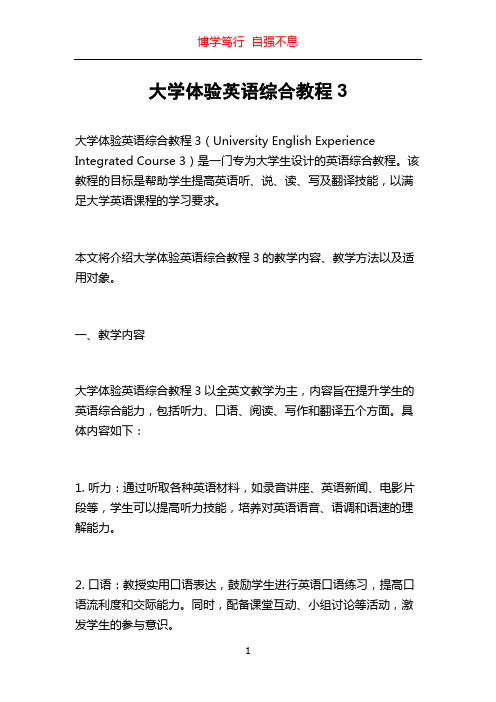
大学体验英语综合教程3大学体验英语综合教程3(University English Experience Integrated Course 3)是一门专为大学生设计的英语综合教程。
该教程的目标是帮助学生提高英语听、说、读、写及翻译技能,以满足大学英语课程的学习要求。
本文将介绍大学体验英语综合教程3的教学内容、教学方法以及适用对象。
一、教学内容大学体验英语综合教程3以全英文教学为主,内容旨在提升学生的英语综合能力,包括听力、口语、阅读、写作和翻译五个方面。
具体内容如下:1. 听力:通过听取各种英语材料,如录音讲座、英语新闻、电影片段等,学生可以提高听力技能,培养对英语语音、语调和语速的理解能力。
2. 口语:教授实用口语表达,鼓励学生进行英语口语练习,提高口语流利度和交际能力。
同时,配备课堂互动、小组讨论等活动,激发学生的参与意识。
3. 阅读:通过阅读各类英文文章、小说、诗歌等,学生将提升阅读理解能力、词汇量和语法知识。
同时,教授阅读技巧,如快速阅读、理解主旨等。
4. 写作:通过指导学生写作各种文体,如图表描述、论述性文章、电子邮件等,培养学生的写作能力和文章结构组织能力。
此外,还包括写作规范、语法纠错等指导。
5. 翻译:教授学生英汉互译的技巧和方法,通过翻译文本提高学生的词汇量和语法应用能力。
同时,还包括文化差异和语言习惯等方面的讲解。
二、教学方法大学体验英语综合教程3采用了多种教学方法,以提高教学效果和学生的参与度。
其中包括:1. 互动式教学:教师通过提问、讨论和小组活动等形式,激发学生的学习兴趣,并促进学生之间的合作和交流。
2. 情境教学:通过提供真实生活或工作场景,让学生在实际情境中运用所学英语知识,培养学生的实际应用能力。
3. 多媒体教学:利用音频、视频、课件等多媒体资料,帮助学生更好地理解和掌握所学内容,提高学习效果。
4. 自主学习:鼓励学生积极主动参与课堂,自主学习和思考,通过自主解决问题来提升学习能力和学习兴趣。
大学体验英语3第三版教案

课程名称:大学英语授课对象:大学一年级学生课时:2课时教学目标:1. 培养学生的英语听说能力,提高学生的英语交流水平。
2. 通过阅读、听力、口语等练习,让学生掌握一定的词汇和语法知识。
3. 培养学生自主学习的能力,提高学生分析问题和解决问题的能力。
教学重点:1. 词汇和语法知识的应用。
2. 听力理解能力的提高。
3. 口语表达能力的提升。
教学难点:1. 词汇的准确理解和运用。
2. 听力材料中的细节把握。
3. 口语表达时的流畅性和准确性。
教学内容:1. 课文:A New Adventure2. 单元词汇和短语3. 单元语法:现在进行时教学步骤:第一课时一、导入1. 利用多媒体展示与课文相关的图片或视频,激发学生的学习兴趣。
2. 引导学生回顾上一节课的内容,复习相关词汇和语法。
二、课文学习1. 阅读课文,让学生了解文章大意。
2. 分组讨论,让学生总结课文中的主要内容和人物关系。
3. 指导学生分析课文中的语法结构,讲解现在进行时的用法。
三、词汇和短语1. 列出课文中的重点词汇和短语,让学生朗读并解释其含义。
2. 通过游戏或竞赛等形式,让学生运用所学词汇和短语进行对话。
四、听力训练1. 播放听力材料,让学生完成听力练习。
2. 解答听力练习中的问题,讲解听力技巧。
五、总结1. 回顾本节课所学内容,让学生自我检测学习效果。
2. 布置课后作业,巩固所学知识。
第二课时一、复习1. 复习上一节课的课文、词汇和短语。
2. 学生展示课后作业,教师点评。
二、口语练习1. 分组进行角色扮演,模拟课文中的场景。
2. 学生轮流发言,教师点评并纠正发音和语法错误。
三、语法讲解1. 结合实际例句,讲解现在进行时的用法。
2. 学生练习运用现在进行时进行描述。
四、总结1. 回顾本节课所学内容,让学生自我检测学习效果。
2. 布置课后作业,巩固所学知识。
教学评价:1. 通过课堂提问、小组讨论、角色扮演等形式,评价学生的参与度和学习效果。
2. 通过课后作业的完成情况,评价学生对知识点的掌握程度。
大学体验英语教案第三册(精简版)

大学体验英语教案第三册编号:Experience3-3-1
大学体验英语教案第三册编号:Experience3-3-2
大学体验英语教案第三册编号:Experience3-3-3
大学体验英语教案第三册编号:Experience3-4-2
大学体验英语教案第三册编号:Experience3-3-4
大学体验英语教案第三册编号:Experience 3-4-1
大学体验英语教案第三册编号:Experience 3-4-3
大学体验英语教案第三册编号:Experience3-4-4
大学体验英语教案第三册编号:Experience3-5-1
大学体验英语教案第三册编号:Experience3-5-2
大学体验英语教案第三册编号:Experience3-5-3
大学体验英语教案第三册编号:Experience3-5-4
大学体验英语教案第三册编号:Experience3-6-1
大学体验英语教案第三册编号:Experience3-6-2
大学体验英语教案第三册编号:Experience3-6-3
大学体验英语教案第三册编号:Experience3-6-4
大学体验英语教案第三册编号:
E3-7-1
3
3
3
3
3
3
3。
艺体类-玉溪师范学院
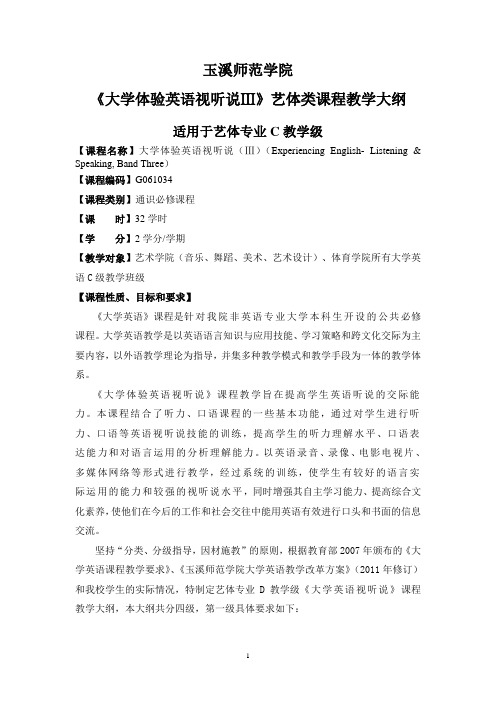
玉溪师范学院《大学体验英语视听说Ⅲ》艺体类课程教学大纲适用于艺体专业C教学级【课程名称】大学体验英语视听说(Ⅲ)(Experiencing English- Listening & Speaking, Band Three)【课程编码】G061034【课程类别】通识必修课程【课时】32学时【学分】2学分/学期【教学对象】艺术学院(音乐、舞蹈、美术、艺术设计)、体育学院所有大学英语C级教学班级【课程性质、目标和要求】《大学英语》课程是针对我院非英语专业大学本科生开设的公共必修课程。
大学英语教学是以英语语言知识与应用技能、学习策略和跨文化交际为主要内容,以外语教学理论为指导,并集多种教学模式和教学手段为一体的教学体系。
《大学体验英语视听说》课程教学旨在提高学生英语听说的交际能力。
本课程结合了听力、口语课程的一些基本功能,通过对学生进行听力、口语等英语视听说技能的训练,提高学生的听力理解水平、口语表达能力和对语言运用的分析理解能力。
以英语录音、录像、电影电视片、多媒体网络等形式进行教学,经过系统的训练,使学生有较好的语言实际运用的能力和较强的视听说水平,同时增强其自主学习能力、提高综合文化素养,使他们在今后的工作和社会交往中能用英语有效进行口头和书面的信息交流。
坚持“分类、分级指导,因材施教”的原则,根据教育部2007年颁布的《大学英语课程教学要求》、《玉溪师范学院大学英语教学改革方案》(2011年修订)和我校学生的实际情况,特制定艺体专业D教学级《大学英语视听说》课程教学大纲,本大纲共分四级,第一级具体要求如下:1.听力理解能力:能听懂英语授课,能听懂日常英语谈话和一般性题材讲座,能基本听懂慢速英语节目,语速为每分钟80词左右,能掌握其中心大意,能运用基本的听力技巧帮助理解。
2.口语表达能力:能在学习过程中用英语交流,能就某一主题进行讨论,能就日常话题和英语国家的人士进行交谈,能就所熟悉的话题经准备后作简短发言,表达比较清楚,语音、语调基本正确,能在交谈中使用基本的会话策略,能简要表达个人的观点。
大学英语III课程教学英大纲(定版)
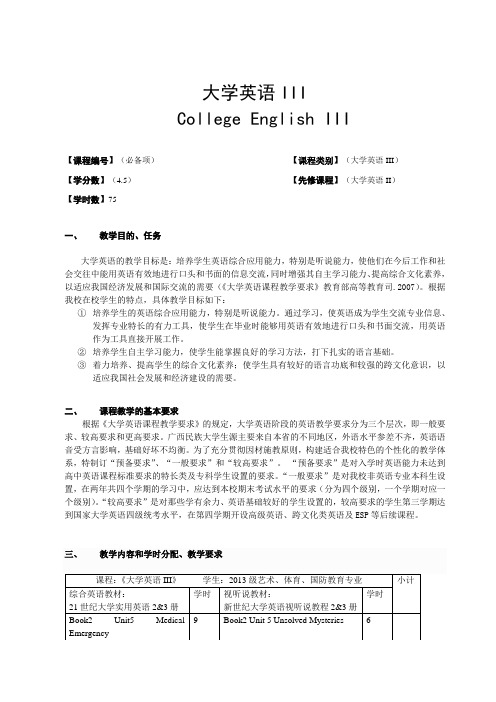
大学英语IIICollege English III【课程编号】(必备项)【课程类别】(大学英语III)【学分数】(4.5)【先修课程】(大学英语II)【学时数】75一、教学目的、任务大学英语的教学目标是:培养学生英语综合应用能力,特别是听说能力,使他们在今后工作和社会交往中能用英语有效地进行口头和书面的信息交流,同时增强其自主学习能力、提高综合文化素养,以适应我国经济发展和国际交流的需要(《大学英语课程教学要求》教育部高等教育司.2007)。
根据我校在校学生的特点,具体教学目标如下:①培养学生的英语综合应用能力,特别是听说能力。
通过学习,使英语成为学生交流专业信息、发挥专业特长的有力工具,使学生在毕业时能够用英语有效地进行口头和书面交流,用英语作为工具直接开展工作。
②培养学生自主学习能力,使学生能掌握良好的学习方法,打下扎实的语言基础。
③着力培养、提高学生的综合文化素养;使学生具有较好的语言功底和较强的跨文化意识,以适应我国社会发展和经济建设的需要。
二、课程教学的基本要求根据《大学英语课程教学要求》的规定,大学英语阶段的英语教学要求分为三个层次,即一般要求、较高要求和更高要求。
广西民族大学生源主要来自本省的不同地区,外语水平参差不齐,英语语音受方言影响,基础好坏不均衡。
为了充分贯彻因材施教原则,构建适合我校特色的个性化的教学体系,特制订“预备要求”、“一般要求”和“较高要求”。
“预备要求”是对入学时英语能力未达到高中英语课程标准要求的特长类及专科学生设置的要求。
“一般要求”是对我校非英语专业本科生设置,在两年共四个学期的学习中,应达到本校期末考试水平的要求(分为四个级别,一个学期对应一个级别)。
“较高要求”是对那些学有余力、英语基础较好的学生设置的,较高要求的学生第三学期达到国家大学英语四级统考水平,在第四学期开设高级英语、跨文化类英语及ESP等后续课程。
教学要求:《大学英语III》学习结束,本级学生从语言应用能力上应达到以下要求:(1)听力理解能力:听懂英语讲课及简短会话和谈话,抓住中心大意和要点。
大学体验英语第三册3、4
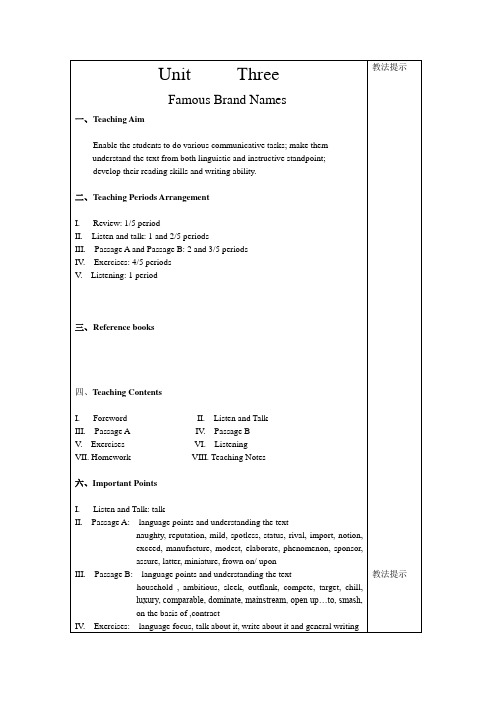
handsome brother.
2)
The miniature furniture matches the room.
15. frown on/ upon: to disapprove of:
1)
Every teacher would frown on cheating in examinations
two different dialogues.)
III. Passage A
Language Points
1.
naughty : adj. (esp. of children) behaving badly and not being
obedient(of behavior)bad
1) Tom used to be a naughty boy and get into lots of trouble.
1) She can’t accept even mild criticism of her work.
教法提示
2) I prefer a mild cigar if you don’t mind.
1.
spotless: adj. extremely clean
1) Even in the most spotless homes, carpets need regular
7.
notion: n. an idea, belief, or opinion; concept
1)
Have you any notion how much it costs to keep a private
car?
2)
Some conservatives reject the notion that reform is now
大学体验英语3教案
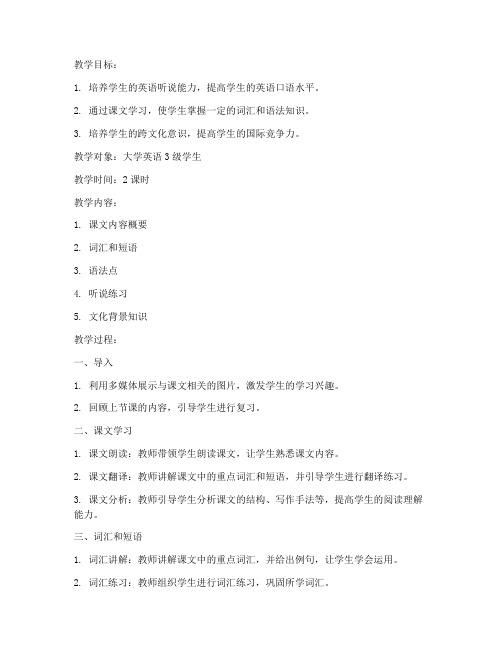
教学目标:1. 培养学生的英语听说能力,提高学生的英语口语水平。
2. 通过课文学习,使学生掌握一定的词汇和语法知识。
3. 培养学生的跨文化意识,提高学生的国际竞争力。
教学对象:大学英语3级学生教学时间:2课时教学内容:1. 课文内容概要2. 词汇和短语3. 语法点4. 听说练习5. 文化背景知识教学过程:一、导入1. 利用多媒体展示与课文相关的图片,激发学生的学习兴趣。
2. 回顾上节课的内容,引导学生进行复习。
二、课文学习1. 课文朗读:教师带领学生朗读课文,让学生熟悉课文内容。
2. 课文翻译:教师讲解课文中的重点词汇和短语,并引导学生进行翻译练习。
3. 课文分析:教师引导学生分析课文的结构、写作手法等,提高学生的阅读理解能力。
三、词汇和短语1. 词汇讲解:教师讲解课文中的重点词汇,并给出例句,让学生学会运用。
2. 词汇练习:教师组织学生进行词汇练习,巩固所学词汇。
四、语法点1. 语法讲解:教师讲解课文中的语法点,如时态、语态等。
2. 语法练习:教师组织学生进行语法练习,提高学生的语法运用能力。
五、听说练习1. 听力练习:教师播放课文听力材料,让学生进行听力练习。
2. 口语练习:教师组织学生进行口语练习,提高学生的口语表达能力。
六、文化背景知识1. 介绍课文相关的文化背景知识,拓宽学生的视野。
2. 引导学生思考课文中的文化差异,培养学生的跨文化意识。
七、课堂小结1. 教师总结本节课的学习内容,强调重点和难点。
2. 学生进行自我总结,分享学习心得。
八、课后作业1. 完成课后练习题,巩固所学知识。
2. 查阅相关资料,了解课文中的文化背景知识。
教学评价:1. 通过课堂提问、口语练习等方式,了解学生的学习情况。
2. 课后作业的完成情况,评估学生的学习效果。
教学资源:1. 多媒体课件2. 《大学体验英语3》教材3. 课后练习册4. 网络资源备注:在教学过程中,教师应根据学生的实际情况,灵活调整教学内容和教学方法,以提高学生的学习效果。
“大学体验英语读写三级”课程学习指南
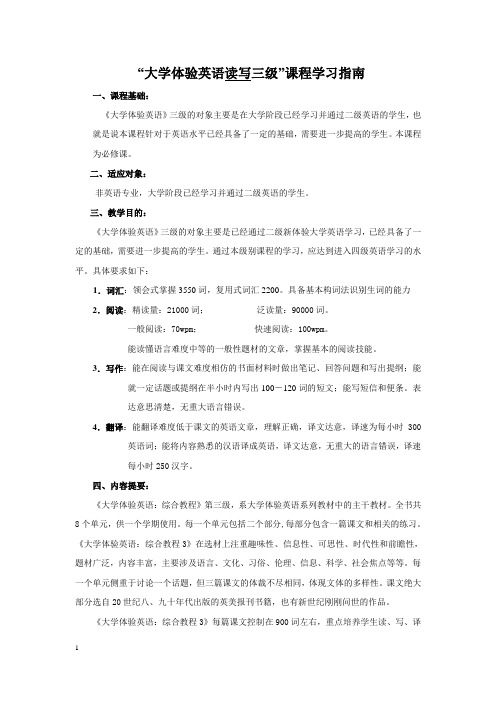
“大学体验英语读写三级”课程学习指南一、课程基础:《大学体验英语》三级的对象主要是在大学阶段已经学习并通过二级英语的学生,也就是说本课程针对于英语水平已经具备了一定的基础,需要进一步提高的学生。
本课程为必修课。
二、适应对象:非英语专业,大学阶段已经学习并通过二级英语的学生。
三、教学目的:《大学体验英语》三级的对象主要是已经通过二级新体验大学英语学习,已经具备了一定的基础,需要进一步提高的学生。
通过本级别课程的学习,应达到进入四级英语学习的水平。
具体要求如下:1.词汇:领会式掌握3550词,复用式词汇2200。
具备基本构词法识别生词的能力2.阅读:精读量:21000词;泛读量:90000词。
一般阅读:70wpm;快速阅读:100wpm。
能读懂语言难度中等的一般性题材的文章,掌握基本的阅读技能。
3.写作:能在阅读与课文难度相仿的书面材料时做出笔记、回答问题和写出提纲;能就一定话题或提纲在半小时内写出100-120词的短文;能写短信和便条。
表达意思清楚,无重大语言错误。
4.翻译:能翻译难度低于课文的英语文章,理解正确,译文达意,译速为每小时300英语词;能将内容熟悉的汉语译成英语,译文达意,无重大的语言错误,译速每小时250汉字。
四、内容提要:《大学体验英语:综合教程》第三级,系大学体验英语系列教材中的主干教材。
全书共8个单元,供一个学期使用。
每一个单元包括二个部分,每部分包含一篇课文和相关的练习。
《大学体验英语:综合教程3》在选材上注重趣味性、信息性、可思性、时代性和前瞻性,题材广泛,内容丰富,主要涉及语言、文化、习俗、伦理、信息、科学、社会焦点等等。
每一个单元侧重于讨论一个话题,但三篇课文的体裁不尽相同,体现文体的多样性。
课文绝大部分选自20世纪八、九十年代出版的英美报刊书籍,也有新世纪刚刚问世的作品。
《大学体验英语:综合教程3》每篇课文控制在900词左右,重点培养学生读、写、译的技能。
五、自主学习授课模式:基于计算机和课堂的英语多媒体教学模式是为了帮助学生达到大学英语教学要求所设计的一种新型英语教学模式。
大学体验英语第三版教案
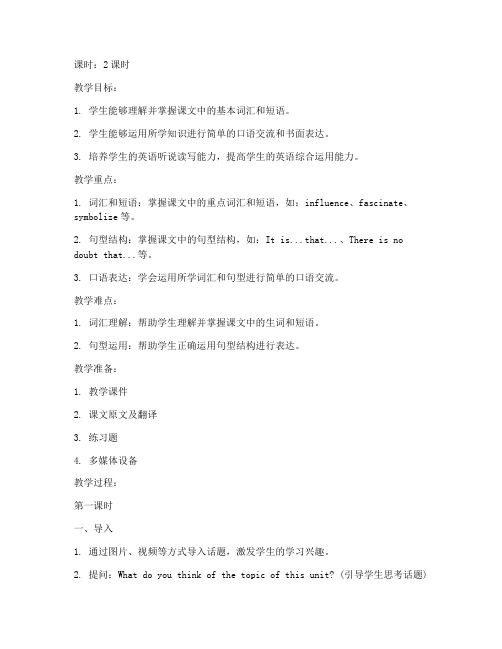
课时:2课时教学目标:1. 学生能够理解并掌握课文中的基本词汇和短语。
2. 学生能够运用所学知识进行简单的口语交流和书面表达。
3. 培养学生的英语听说读写能力,提高学生的英语综合运用能力。
教学重点:1. 词汇和短语:掌握课文中的重点词汇和短语,如:influence、fascinate、symbolize等。
2. 句型结构:掌握课文中的句型结构,如:It is...that...、There is no doubt that...等。
3. 口语表达:学会运用所学词汇和句型进行简单的口语交流。
教学难点:1. 词汇理解:帮助学生理解并掌握课文中的生词和短语。
2. 句型运用:帮助学生正确运用句型结构进行表达。
教学准备:1. 教学课件2. 课文原文及翻译3. 练习题4. 多媒体设备教学过程:第一课时一、导入1. 通过图片、视频等方式导入话题,激发学生的学习兴趣。
2. 提问:What do you think of the topic of this unit? (引导学生思考话题)二、课文讲解1. 朗读课文,让学生跟读,纠正发音。
2. 讲解课文中的重点词汇和短语,如:influence、fascinate、symbolize等。
3. 分析课文中的句型结构,如:It is...that...、There is no doubt that...等。
4. 翻译课文,帮助学生理解课文内容。
三、课堂活动1. 词汇游戏:通过游戏形式,让学生在轻松愉快的氛围中巩固所学词汇。
2. 语法练习:让学生运用所学句型结构进行表达,提高学生的语法运用能力。
四、小结1. 回顾本节课所学内容,总结重点词汇和短语。
2. 强调句型结构的运用。
第二课时一、复习1. 复习上节课所学内容,检查学生的学习效果。
2. 提问:Do you remember the key words and phrases in this unit? (检查学生对词汇的掌握)二、口语练习1. 学生分组,进行角色扮演,运用所学词汇和句型进行口语交流。
大学体验英语第三册电子教案(第二版)unit3-B3U3-Data bank for class design-B3-U3-R-I

ቤተ መጻሕፍቲ ባይዱ
2. Lincoln Memorial
At the far west end of the Mall, the Lincoln Memorial is modelled upon a Doric temple, enclosed by a colonnade and fronted by a long reflecting pool. During the Civil Rights March on Washington in 1963, Dr Martin Luther King Jr. delivered his epic "I Have a Dream" speech, not from the steps of the White House or the US Capitol, but here.
3. Washington Monument
The Mall's most prominent feature, the Washington Monument is an unadorned marble obelisk built in memory of George Washington. At 555ft it's the tallest allmasonry structure in the world.
The Lincoln Memorial is a fitting tribute to the man who held the country together during the Civil War and thereby put an end to slavery in the US. A craggy likeness of Abraham Lincoln sits firmly grasping the arms of his throne-like chair, apparently deep in thought. The inscriptions of Lincoln's two most celebrated speeches – the Gettysburg Address and the Second Inaugural Address – are carved on north and south walls.
大学体验英语第三版_教案
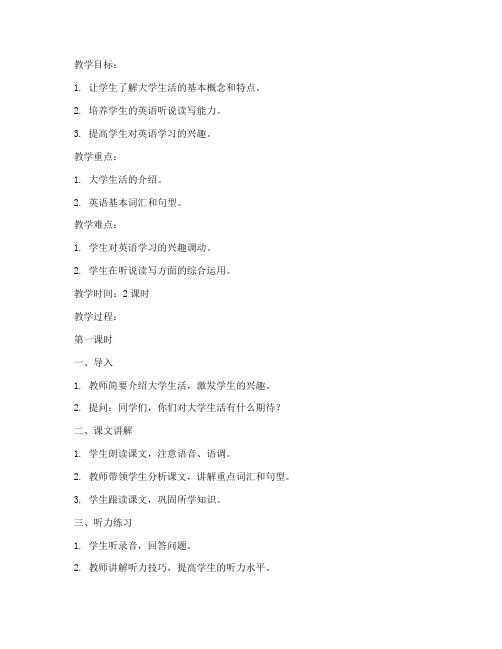
教学目标:1. 让学生了解大学生活的基本概念和特点。
2. 培养学生的英语听说读写能力。
3. 提高学生对英语学习的兴趣。
教学重点:1. 大学生活的介绍。
2. 英语基本词汇和句型。
教学难点:1. 学生对英语学习的兴趣调动。
2. 学生在听说读写方面的综合运用。
教学时间:2课时教学过程:第一课时一、导入1. 教师简要介绍大学生活,激发学生的兴趣。
2. 提问:同学们,你们对大学生活有什么期待?二、课文讲解1. 学生朗读课文,注意语音、语调。
2. 教师带领学生分析课文,讲解重点词汇和句型。
3. 学生跟读课文,巩固所学知识。
三、听力练习1. 学生听录音,回答问题。
2. 教师讲解听力技巧,提高学生的听力水平。
四、口语练习1. 学生分组讨论,分享自己对大学生活的看法。
2. 教师点评,纠正发音和语法错误。
五、写作练习1. 学生根据课文内容,写一篇短文介绍自己的大学生活。
2. 教师批改,指导学生修改。
第二课时一、复习1. 学生朗读课文,复习重点词汇和句型。
2. 教师提问,检查学生对课文的理解。
二、阅读练习1. 学生阅读课文,找出关键信息。
2. 教师讲解阅读技巧,提高学生的阅读水平。
三、词汇练习1. 学生根据课文内容,完成词汇练习。
2. 教师讲解词汇用法,巩固所学知识。
四、听力练习1. 学生听录音,回答问题。
2. 教师讲解听力技巧,提高学生的听力水平。
五、口语练习1. 学生分组讨论,分享自己对大学生活的看法。
2. 教师点评,纠正发音和语法错误。
六、总结1. 教师总结本节课的学习内容,强调重点。
2. 学生分享自己的学习心得,提出疑问。
教学评价:1. 课后收集学生作业,检查学生对课文内容的掌握程度。
2. 课堂表现,包括学生的参与度、发音、语法等方面。
3. 定期进行听力、阅读、写作等测试,评估学生的英语综合能力。
- 1、下载文档前请自行甄别文档内容的完整性,平台不提供额外的编辑、内容补充、找答案等附加服务。
- 2、"仅部分预览"的文档,不可在线预览部分如存在完整性等问题,可反馈申请退款(可完整预览的文档不适用该条件!)。
- 3、如文档侵犯您的权益,请联系客服反馈,我们会尽快为您处理(人工客服工作时间:9:00-18:30)。
课程编号:000046课程名称:大学英语2-3 (College English 2-3)《大学英语2-3》教学大纲一、课程的性质、地位和任务本课程是中文系和化生系分层次教学班中非英语专业大学二年级学生的公共课。
大学英语是以英语语言知识与应用技能、学习策略和跨文化交际为主要内容,以外语教学理论为指导,集多种教学模式和教学手段为一体的教学体系。
其教学目的是培养学生的综合应用能力,使他们在今后工作和社会交往中能用英语有效地进行口头和书面的信息交流,同时提高他们的自主学习的能力和综合文化素养,以适应我国社会发展的需要和国际交流的需要。
在教学中应给学生创造更多了解生活、了解社会的机会,使学生能结合社会实际使用英语进行涉外交际。
要坚持教书育人,因材施教;要以学生为中心,精心设计课堂活动;课堂设计要体现老师的特色,充分发挥老师的编导,策划,和驾驭学生课堂活动的能力。
所用教材包括《大学体验英语综合教程》(Integrated Book)、《大学英语泛读教程》(Extensive Reading)、《大学英语泛听教程》(Extensive Listening)三种。
其中《综合教程》、《泛听教程》为课堂教学的主干教材,《泛读教程》《一课一练》供学生自主学习使用。
二者紧密配合,相辅相成。
《综合教程》每册有8个单元。
每个单元都由听说(Listen and Talk)、阅读(Read and Explore)、写作(Write and Produce)和文化沙龙(Culture and Salon)4个部分组成。
以听说(Listen and Talk)、阅读(Read and Explore)、写作(Write and Produce)为教学内容,文化沙龙(Culture and Salon)作为学生的课外读物。
具体安排见课程内容及学时分配。
二、课程章节的基本要求及学时分配三、教学章节教学目的、基本内容要求、重点和难点Unit 1 Caring for Our Earth(一)目的与要求本单元主要讨论地球环境污染,全球气候变暖等问题。
学生将结合对环境问题已有的知识和课前及时的准备,针对本话题进行听力、对话及讨论等交际活动,从而达成共识,找到解决问题的办法。
(二)教学内容1.主要内容通过Passage A和Passage B阅读,要求学生背记文章中出现的四级词汇和课后所列短语;对学习较好的同学还可以要求他们背记课文中出现的六级词汇。
在精读文章的基础上练习根据上下文相关提示分析生词的意思这一阅读技巧,以及用引申义来翻译某些词汇这一翻译技巧。
练习主题句——展开句——结论句这一段落结构的写作技巧;了解英文邀请信的格式和内容安排。
《扩展教程》本单元Passage C 和Passage D的内容与 Passage A / B相关,可作为补充阅读材料,由学生自己课外阅读,以丰富相关内容和相关信息,加强对以上练习重点的深入练习。
2.问题与应用(能力要求)词汇的意义,搭配关系和习惯用法;翻译中词义的引申;段落写作:主题句——展开句——结论句的结构。
练习以巩固所学单元的语言点为主要目标,掌握解题的要领。
练习重点是:口语练习(以本单元的主题为基本话题)、汉译英、词汇练习和语法练习和作文。
Unit 2 Nobel Prize Winners(一) 目的与要求本单元引入了学生非常感兴趣的话题——诺贝尔奖及其获得者。
从介绍已获诺贝尔奖的人物及其科研的听力短文和图片入手,为同学们提供了有价值的国际高端信息。
从而自然引到学生对未来事业及科技与社会的讨论。
Passage A和Passage B分别记叙了伟大科学家爱因斯坦和诺贝尔化学奖得主阿莫得•扎威尔的事迹,是很好的教育题材。
(二)教学内容1.主要内容在讲解课文时要注意抓重点,突出对伟人奉献科学事业精神的倡导。
同时要求学生背记两篇文章中出现的四级词汇和课后给出的短语,学习较好的同学可以包括六级词汇。
在精讲课文的基础上,对某些词汇的构成进行分析,注意扩展其相关词汇,使学生建立构词法的知识。
介绍翻译中的增补这一翻译技巧。
在分析记叙文的基础上,指出按时间顺序展开文章的重要性。
《扩展教程》本单元Passage C 和Passage D的内容与 Passage A / B相关,可作为补充阅读材料,由学生自己课外阅读,以丰富相关内容和相关信息,加强对以上练习重点的深入练习。
2.问题与应用(能力要求)词汇练习;词汇构成法的练习;翻译增补法的练习;篇章写作的时间顺序法。
(三)重点和难点练习以巩固所学单元的语言点为主要目标,要突出重点,精讲多练,明确练习的目的,掌握解题的要领。
本课的练习重点是:口语练习(以本单元的主题为基本话题)、汉译英、词汇练习和语法练习和作文。
Unit 3 Famous Brand Names(一) 目的与要求本单元讨论的是著名的商标及商标的作用。
这是最贴近同学生活的话题,也是方便锻炼学生创造性和发散性思维的话题。
在听说练习中可包括让同学讨论自己熟悉的商标,对商标的看法;设置情景让同学为商品设计商标等趣味活动。
(二)教学内容1.主要内容在讲解课文时,要联系实际,提出问题,展开课堂讨论。
在语言学习方面要求同学们充分理解课文,背记Passage A和Passage B中出现的四级词汇和课后给出的短语,学习较好的同学可以包括六级词汇。
在精讲课文中,注意对不同层次理解的练习,如词汇概念的理解、命题的理解、上下文语境的理解和篇章结构的理解等。
注意翻译个别句子时练习省略的技巧。
以按步骤记录过程的方法来写作说明体裁的文章。
《扩展教程》本单元Passage C 和Passage D的内容与 Passage A / B相关,可作为补充阅读材料,由学生自己课外阅读,以丰富相关内容和相关信息,加强对以上练习重点的深入练习。
2.问题与应用(能力要求)词汇练习;略译法;写作技巧——过程法,以及英文广告的内容和格式。
练习以巩固所学单元的语言点为主要目标,要突出重点,精讲多练,明确练习的目的,掌握解题的要领。
练习重点是:口语练习(以本单元的主题为基本话题)、汉译英、词汇练习和语法练习和作文。
Unit 4 Cloning and Ethics(一)目的与要求本单元涉及到了当今科技的尖端——克隆技术,同时又与伦理道德这一主题很好的结合在一起展现在学生面前。
这就使得同学在生涩的科技面前有话可说。
但可能会涉及较多的生词,老师应注意提供更多的有趣、简易的资料供学生参考,这样更容易激发学生表达,完成交际这部分任务。
(三)教学内容1.主要内容在语言学习方面,要求同学们充分理解课文,认真分析文章的语篇结构。
背记Passage A 和Passage B 所给出的四级词汇和相应的短语。
对学习较好的同学要有更高的要求,要能掌握书中的六级词汇。
通过课文精讲,学习词类转译法。
写作部分练习按空间顺序写作。
《扩展教程》本单元Passage C 和Passage D的内容与 Passage A / B相关,可作为补充阅读材料,由学生自己课外阅读,以丰富相关内容和相关信息,加强对以上练习重点的深入练习。
2.问题与应用(能力要求)词汇练习;词类转译法;按空间顺序描述事物或记叙事件的写作方法。
(三)重点和难点练习以巩固所学单元的语言点为主要目标,要突出重点,精讲多练,明确练习的目的,掌握解题的要领。
本课的练习重点是:口语练习(以本单元的主题为基本话题)、汉译英、词汇练习和语法练习和作文。
Unit 5 Lifelong Education(一)目的与要求活到老,学到老。
本单元主题正应了此句格言。
在此,语言听说部分会涉及到对幼儿教育及中老年人学习的讨论。
(二)教学内容1.主要内容在语言学习方面,要求同学们充分理解Passage A和Passage B两篇课文,认真分析文章的语篇结构,掌握语言要点,背记课后给出的四级词汇和相应的词组。
对学习较好的同学,要有更高的要求,要掌握相关的六级词汇。
练习在特定语境中对某些句子意义的理解。
练习分句译法。
练习例证法的写作。
《扩展教程》本单元Passage C 和Passage D的内容与 Passage A / B相关,可作为补充阅读材料,由学生自己课外阅读,以丰富相关内容和相关信息,加强对以上练习重点的深入练习。
2.问题与应用(能力要求)词汇练习;阅读技巧;分译法;例证法写作。
(三)重点和难点练习课以巩固所学单元的语言点为主要目标,要突出重点,精讲多练,明确练习的目的,掌握解题的要领。
练习重点是:口语练习(以本单元的主题为基本话题)、汉译英、词汇练习和语法练习和作文。
Unit 6 Travel Around the World(一)目的与要求全世界旅游业的发展使得主题显得那样时尚而有趣。
大量的图片、丰富的旅游经验和广阔的文化知识都可以引起同学热烈的发言。
本单元可设置情景,发挥同学即兴表演的能力。
(二)教学内容1.主要内容在两篇课文的学习上,要注意理解内容,分析段落,注意全篇的结构模式,学习模仿作者的写作技巧。
同时要背记 Passage A 和 Passage B 所给出的四级词汇和相应的短语。
对学习较好的同学要有更高的要求,可要求他们背记相关的六级词汇。
翻译技巧部分练习复合句的译法。
段落写作中注意对比事物的写作方法。
《扩展教程》本单元Passage C 和Passage D的内容与 Passage A / B相关,可作为补充阅读材料,由学生自己课外阅读,以丰富相关内容和相关信息,加强对以上练习重点的深入练习。
2.问题与应用(能力要求)词汇练习;复合句的译法;对比的段落写作法。
(三)重点和难点巩固所学单元的语言点为主要目标,要突出重点,精讲多练,明确练习的目的,掌握解题的要领。
重点是:口语练习(以本单元的主题为基本话题)、汉译英、词汇练习和语法练习和作文。
Unit 7 Drug Abuse(一) 目的与要求本单元讨论毒品这个与我们遥远而又熟悉的话题。
听力口语练习单元要对毒品的危害和怎样拒绝毒品等话题进行重点讨论和教育。
可利用更新颖的视听材料向同学们介绍。
通过课文学习,让学生以他认为鉴,增强防范意识;杜绝坏的生活习惯。
(二)教学内容1.主要内容在语言学习上要充分理解课文,分析篇章结构,同时要背记 A、B两篇文章中的四级词汇和相应的短语。
对学习基础较好的同学,可要求他们掌握相关的六级词汇。
练习阅读中对关联词的注意和理解。
注意it的翻译技巧。
写作练习中注意因果关系段落的写作方法。
《扩展教程》本单元Passage C 和Passage D的内容与 Passage A / B相关,可作为补充阅读材料,由学生自己课外阅读,以丰富相关内容和相关信息,加强对以上练习重点的深入练习。
2.问题与应用(能力要求)词汇练习;篇章中关联词或词组的使用;it的多种翻译练习;因果关系段落写作。
